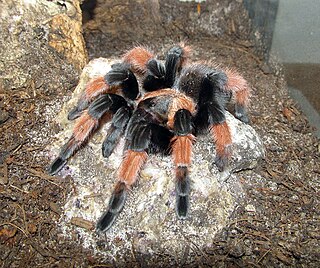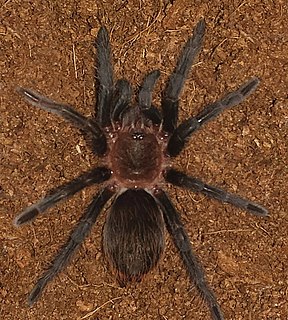
Brachypelma is a genus of spiders in the family Theraphosidae (tarantulas). They may have bodies up to 6 cm long with legs of similar or greater lengths. Some species have brightly colored legs, with red or orange marks and rings.

Barychelidae, also known as brushed trapdoor spiders, is a spider family with about 300 species in 42 genera. Most spiders in this family build trapdoor burrows. For example, the 20 millimetres (0.79 in) long Sipalolasma builds its burrow in rotted wood, with a hinged trapdoor at each end. The 10 millimetres (0.39 in) long Idioctis builds its burrow approximately 5 centimetres (2.0 in) deep, just below the high tide level, sealing the opening with a thin trapdoor.

Brachypelma albiceps is a species of spider in the tarantula family, Theraphosidae. It is known as the Mexican golden red rump tarantula or the Amula red rump tarantula. The carapace is a light golden color and the abdomen dark, covered with long red hairs. Females typically live for about 15 years. Males usually live about 5 years or up to 12 months after the last molt.
Anoploscelus is a genus of East African tarantulas that was first described by Reginald Innes Pocock in 1897. It was erected for the species Anoploscelus celeripes, based on a single male collected near Lake Tanganyika in modern day Tanzania. It was synonymized with Phoneyusa from 1985 to 1990. As of December 2019 it contains two species, including A. lesserti, first found in Rwanda in 1946.
Batesiella is a monotypic genus of African tarantulas containing the single species, Batesiella crinita. It was first described by Reginald Innes Pocock in 1903, and is found in Cameroon. It is named in honor of the collector, G. L. Bates. It was synonymized with Encyocrates from 1985 to 1990.

Cyriopagopus is a genus of southeast Asian tarantulas found from Myanmar to the Philippines. As of March 2017, the genus includes species formerly placed in Haplopelma. It was first described by Eugène Louis Simon in 1887.
The Ischnocolinae are a problematic subfamily of tarantulas. In 1892, Eugène Simon based the group, which he noted was only weakly homogeneous, on the presence of divided tarsal scopulae. This feature was later considered to be plesiomorphic, and both morphological and molecular phylogenetic studies have shown that, as traditionally circumscribed, the subfamily is not monophyletic. A much more narrowly defined Ischnocolinae sensu stricto was proposed in 2014. One of the authors of that proposal subsequently said that no further taxonomic changes should be considered until there had been a more comprehensive sampling of the subfamily. As of January 2021, the status of the Ischnocolinae remains unresolved.
Reichlingia is a monotypic genus of Central American tarantulas containing the single species, Reichlingia annae. The genus was first described in 2001, and has only been found in Belize.
Euphrictus is a genus of tarantula which is found in Africa. It is part of the subfamily Selenogyrinae.
Annandaliella ermakulamensis is a species of tarantula in the subfamily Selenogyrinae. It is one of three species in the genus Annandaliella and the first to be described in 73 years. It is native to Ermakulam, Kerala State, India.
Trichopelma zebra is a species of ischnocoline tarantula that is known from Panama.

Holothele is a genus of tarantulas that was first described by Ferdinand Anton Franz Karsch in 1879. Originally placed with the curtain-web spiders, it was transferred to the tarantulas in 1980.

Phlogiellus is a genus of tarantulas that was first described by Reginald Innes Pocock in 1897.
Sipalolasma is a genus of brushed trapdoor spiders first described by Eugène Simon in 1892. It is restricted to South Asia and parts of Africa.
Trichopelma is a genus of South American and Caribbean tarantulas first described by Eugène Simon in 1888.
Rhianodes is a monotypic genus of Southeast Asian brushed trapdoor spiders containing the single species, Rhianodes atratus. It was first described by Robert Raven in 1985, and was later renamed to "Rhianodes" because the name was already attributed to a genus of weevils in the subfamily Apostasimerini. These spiders have only been found in Malaysia, Singapore, and Philippines.
Tigidia is a genus of brushed trapdoor spiders first described by Eugène Simon in 1892.
Brachionopus is a genus of South African tarantulas that was first described by Reginald Innes Pocock in 1897. It was transferred to the Theraphosidae from the Barychelidae in 1985.
Harpactirella is a genus of African tarantulas that was first described by William Frederick Purcell in 1902. Originally placed with the brushed trapdoor spiders, it was transferred to the tarantulas in 1985.

Tliltocatl verdezi is a species of spiders in the family Theraphosidae (tarantulas), found in Mexico.






